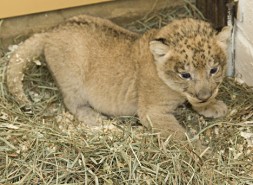We ain’t lion…
The birth of three more lion cubs at the Smithsonian’s National Zoo this morning has contributed to the growth of the Zoo’s lion pride over the past three weeks and has brought the total number of cubs to seven so far. The Zoo’s 6-year-old lion Nababiep gave birth to the three newest cubs three weeks after her sister, 5-year-old Shera, gave birth to four cubs. Because it is not uncommon for intervals between births to be several hours long, keepers are continuing to monitor Nababiep today for additional cubs.
Luke, the Zoo’s 4-year-old male lion, is father to all seven cubs and is the most genetically valuable lion in the Association of Zoos and Aquariums’ Species Survival Plan for African lions (Panthera leo). An SSP matches individual animals across the country for breeding in order to maintain a healthy, genetically diverse and self-sustaining population.
“We are very proud to play a role in the management of this important species,” said Dennis Kelly, director of the Smithsonian’s National Zoological Park. “I am thrilled that everyone can watch the cubs in the very early days of their lives via our webcam. I know visitors to the National Zoo will be excited to follow the cubs as they interact with the adults, play with one another and grow up.”
 Nababiep appeared to go into labor at 1:20 a.m. this morning and the first cub was born around 8:04 a.m. The second cub was born around 9:15 a.m., while the third was born around 10:30 a.m. Since then, all three cubs have been active and at least two appear to have nursed so far. (A short video clip of the newest cubs is available on the Zoo’s YouTube page.)
Nababiep appeared to go into labor at 1:20 a.m. this morning and the first cub was born around 8:04 a.m. The second cub was born around 9:15 a.m., while the third was born around 10:30 a.m. Since then, all three cubs have been active and at least two appear to have nursed so far. (A short video clip of the newest cubs is available on the Zoo’s YouTube page.)
On May 18, Nababiep gave birth to a single male cub, but it died two days later after a straw seed became lodged in its lung which led to pneumonia. The mortality rate for lion cubs (including those that are younger than a year) in captivity in 2009 was about 30 percent, compared to a 67 percent mortality rate for cubs in the wild. Because the first few days of life are the most fragile, animal care staff are cautiously optimistic that the cubs will thrive and are giving both mothers the peace and quiet they need to care for their new families.
“The reality is that there are many risks associated with newborn cubs,” said Craig Saffoe, interim curator of the Zoo’s Great Cats Exhibit. “One of the greatest risks is that the new mother will reject her cubs and not care for them, but we are encouraged by how naturally both of our female lions seem to have taken on the role of motherhood.”
Although the Zoo has managed lions in the past, it has been many years since it had the right combination of animals by age and gender to develop a pride. Doing so successfully has required more than a year’s worth of planning, extensive knowledge of the species’ natural history and an understanding of the individual animals involved. The birth of the lion cubs marks the next step in building a pride, and keepers will slowly introduce the cubs to their aunts, their father and one another with the aim of eventually bringing all nine lions together.
Over the past few weeks, keepers have gradually separated Luke, Shera and Nababiep to give the females privacy and to emulate the natural process. In the wild, lions may wait up to six weeks before introducing their cubs to the rest of the pride. Keepers predict the cubs will not be out in the yard, however, until late fall or early winter, which will give the Zoo’s animal keepers and veterinary team time to examine them.
For photos of the new cubs, visit the National Zoo’s Flickr page. To follow the Zoo’s progress in building a pride and now caring for the cubs, read the updates from the Zoo’s lion keepers and check for news on the Zoo’s Twitter feed and Facebook page.
Shera’s cubs were previously on the lion cub cam, but she has since moved them to a den without a camera. Keepers give Shera the choice to move where she’s most comfortable and it will be her decision to bring the cubs back into a den with a camera.
________________________

Keeper Leigh Pitsko and interim curator of Great Cats Craig Saffoe examine one of 6-year-old Nababiep's cubs. The cubs were born on Sept. 22 to Nababiep and 5-year-old father, Luke. (Photo by Mehgan Murphy)
Oct. 6 The Zoo’s three youngest cubs appear healthy and strong, according to Zoo veterinarians who completed the cubs first health exam Oct.6
“We’re happy to see that the cubs are growing and that each appears to be in good health,” said Jessica Siegal-Willott, supervisory veterinarian at the Zoo. “Naba has done a great job nursing them, and we’ll continue to monitor their development.”
The veterinary team checked the cubs’ mouths and eyes, listened to their hearts and lungs and felt their bellies, but the animals are still too young to receive vaccines. The cubs weigh between 7 and 8 pounds.
Because the cubs are just 2 weeks old, animal care staff continues to be cautiously optimistic. The mortality rate for cubs younger than 1 year old in human care in 2009 was about 30 percent, compared to a 67 percent mortality rate for cubs in the wild. The cubs’ next exam will be in about a month.
Posted: 22 September 2010
- Categories:




